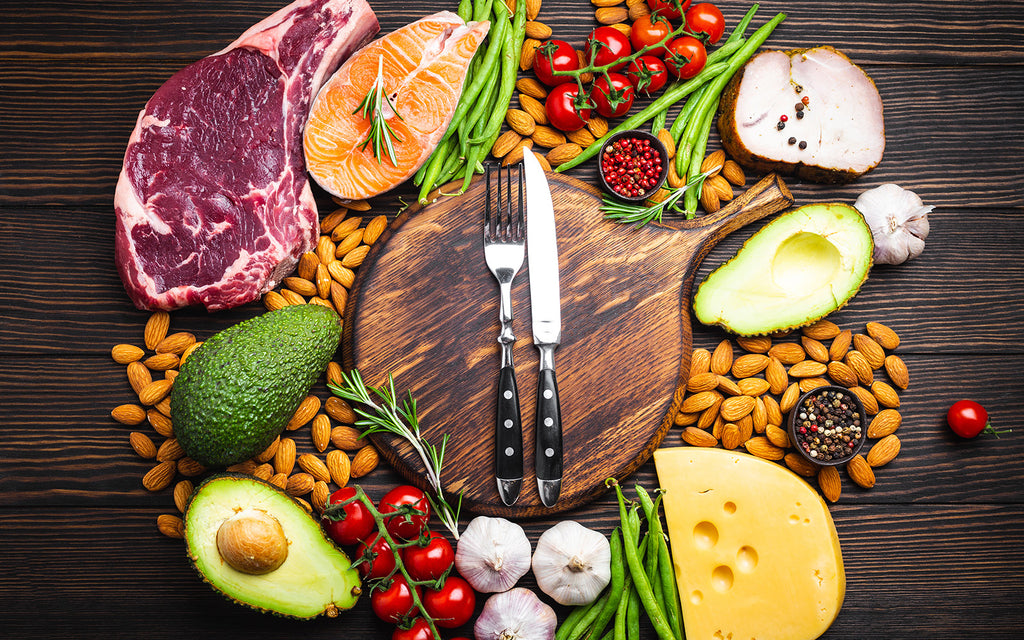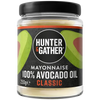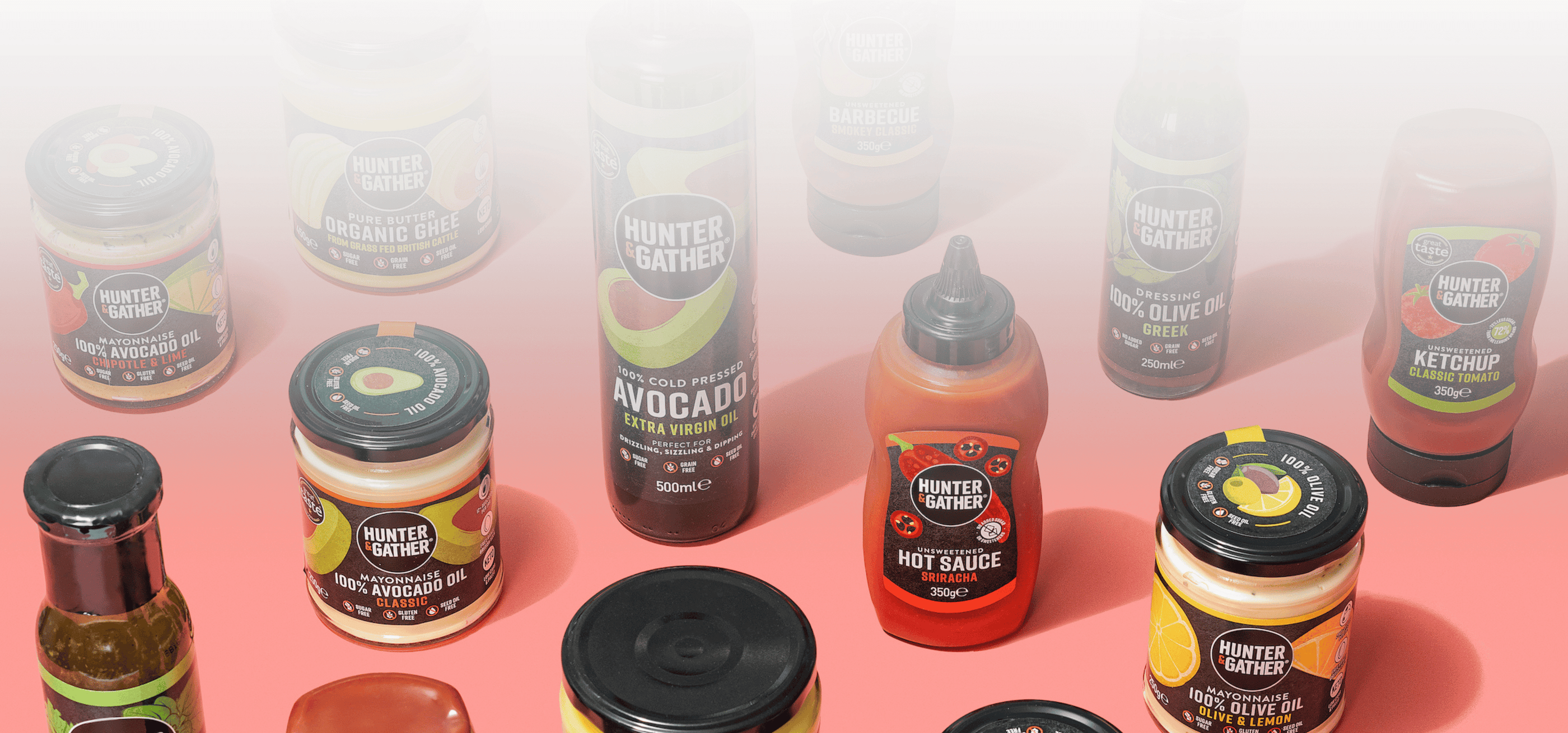Looking to start a ketogenic lifestyle? Below, we share the unofficial guide for the keto diet for beginners.
The keto diet lifestyle offers a number of health benefits. However, if you type ‘keto diet’ into Google, you’ll get heaps of contradictory information. To help dispel any myths and set you up for success, below we explain what the keto diet is, the science behind it and what you can/cannot eat on keto.
What Is the Keto Diet?
The keto diet (short for ketogenic diet) is a high-fat, low-carb diet. The goal of the keto diet is to enter the metabolic state of ketosis, where your body burns fat — rather than glucose — as its primary energy source.
How Does the Keto Diet Work?
On the keto diet, you severely restrict your carbohydrate intake, thereby depriving your body of glucose. With no glucose available, your body switches to an alternative fuel source - fat! Your body starts burning fat, which is transformed into ketone bodies in the liver. These ketone bodies are released into the bloodstream to be used as fuel.
The Health Benefits of the Keto Diet
The keto diet is associated with a number of health benefits, including weight loss, improved insulin sensitivity, decreased risk of Type 2 diabetes, reduced blood sugar, reduced risk of heart disease, improved cholesterol levels and triglycerides, reduced blood pressure and reduced sugar dependency [1].
Here are several sought-after health benefits of the keto diet:
- Promotes weight loss: When you use your own body fat for fuel (rather than glucose), the keto diet promotes fat loss while helping to preserve lean muscle mass [2][3].
- Prevents Type 2 diabetes: Being in a state of ketosis can reduce glucose and insulin levels. This helps to control blood sugar and insulin sensitivity, thereby helping to prevent Type 2 diabetes [1].
- Can help manage neurological conditions: Research shows that the keto diet can slow the onset of Alzheimer’s disease and help control some symptoms related to Parkinson’s disease [4].
- It could help treat epilepsy: The Epilepsy Society states that a keto lifestyle could help decrease seizures and other epilepsy symptoms [5].
Keto Diet for Beginners: What To Eat on Keto

Now that you know what the keto diet is, what does a keto meal plan look like? Below, you’ll learn about the macronutrient breakdown of keto and how to build a keto meal plan.
Keto Macro Breakdown: Fat, Protein and Carbs

On the keto diet, you will eat high amounts of fat, while consuming a moderate protein intake and extremely low carb intake. Typically, the macronutrient breakdown on keto will look something like this:
- High fat: With roughly 75% of your calories coming from fat
- Moderate protein: Where roughly 20% of your calories will come from protein
- Low carbohydrates: Where a mere 5% of your calories will come from carbohydrates (which should be as low as 20 grams of carbs per day)
When selecting carbohydrates, look for carbs with a low net carb count (total grams of carbs per serving – grams of fibre = grams of net carbs), such as leafy green vegetables. In the UK most packaged foods already utilises net carbs but in the U.S, you normally are required to take the fibre from the total grams of carbs.
Keto-Friendly Foods: What To Eat on Keto
Now that you understand how to build a keto-friendly plate, it’s time to construct a diet plan. On keto, enjoy these keto-friendly whole foods:
- High-quality fats: Including avocados, extra virgin olive oil, coconut oil, MCTs and avocado oils
- High-quality protein: Including pork, beef, chicken, seafood, goat, lamb and eggs (select free-range, grass-fed and pasture-finished products whenever possible)
- Nuts and seeds: Including sunflower seeds, almonds, walnuts, cashews (in moderation) and nut butters
- Low-carb veg: Including leafy greens such as kale, swiss chard and rocket, broccoli, cauliflower, bell peppers, courgette and asparagus
- Berries: Including blueberries, raspberries and strawberries
- Seasonings: Including fresh herbs and spices
Foods To Avoid on the Keto Diet
When building a keto shopping list, you will want to avoid high-carb foods. These include:
- Sugar: Including fruit juice, fizzy drinks, sweets, honey, maple syrup and most baked/processed goods
- Grains: Including ‘healthy whole grains’, such as rice, quinoa, oatmeal, bread, wheat and corn
- Legumes: Including kidney beans, black beans, lentils and peanuts
- Alcohol: Including wine and beer
- Seed oils: Including sunflower oil, rapeseed oil or vegetable oil
- Starchy vegetables: Including squash, white potatoes, turnips, parsnips and sweet potatoes
- Most fruits: Including apples, oranges, watermelon, mangos and kiwis
What’s the Difference Between Clean Keto and Lazy Keto?
The keto diet is meant to be a lifestyle — one where you experience a number of health benefits. Unfortunately, many people try to cut corners on keto, opting for foods that may be high in fat and low in carbs but contain very little nutrients.
‘Dirty keto’ is a practice where people look at the macronutrient content of foods, rather than the ingredients themselves. They’ll search for keto dessert recipes online, filling themselves up with keto cakes, keto pie or keto ice cream containing preservatives or low-carb sweeteners. In this regard, they may be following a low-carb, high fat diet, but it’s not a diet optimised for health.
Clean keto is where you focus on whole, real foods — the way keto was designed to be. On a clean keto diet, you’ll fill yourself with high-quality fats and protein, low-carb vegetables and berries.
Keto Diet FAQs: Frequent Questions from Beginners
If you’re just starting the keto diet, you may have a few questions. Below, you’ll find answers to frequently asked questions sent in by the Hunter & Gather community.
Can You Eat Sugar on Keto?
No. Any real-food diet should avoid refined sugars. Sugar is a non-nutrient, packing empty calories that can wreak havoc on your blood sugar levels. On keto, most sugars (even natural sugars) are avoided because they are high in carbs — this includes white sugar, coconut sugar, maple sugar, honey and maple syrup.
However, there are a few low-carb sweeteners that can be consumed in moderation. These include stevia, erythritol, monk fruit, inulin and chicory root.
Can You Drink Coffee and Tea on Keto?
Tea, coffee and espresso are completely keto compliant. However, you will want to leave out any add-ons, including coffee creamer, sugar, honey, soya milk or sweetened almond milk.
If you simply can’t drink your coffee black, we recommend adding a dollop of coconut milk or double cream to your coffee. You could also add a pat of grass-fed butter or a tablespoon of MCT oil to your coffee.
Can You Consume Dairy on Keto?
Full-fat dairy is naturally low in carbs while being high in fat and protein. Therefore, high-quality dairy — like grass-fed cheese or double cream — makes a suitable keto snack.
There are a few dairy products that are naturally higher in carbohydrates and should be avoided. Milk, for example, is high in the sugar lactose, making it unsuitable for the keto diet.
How Can I Increase My Fat Intake?
When converting to a high-fat, low-carb lifestyle it can be difficult to get your daily fat requirements. Consume high-quality fats such as coconut oil, avocado oil, grass-fed butter and cream to increase your daily fat content. You can also cook with coconut oil or drizzle avocado oil over your lunch salad.
Another way to increase your fat intake is to utilise coconut MCT oil. Coconut MCT oil is fractionated coconut oil that keeps the medium-chain fatty acids (fats that are rapidly used by the body for energy). Look for MCT oil that is derived solely from coconuts (no palm oil) and contains either pure C8 (caprylic acid or octanoic acid) or a blend of C8 and C10 (capric acid or decanoic acid). Avoid MCT oils that contain C6 (caproic acid or hexanoic acid) as this has a harsh taste and can cause stomach discomfort.
Keto Diet Side Effects and Risks
Ketosis is a natural, metabolic state — one associated with a number of health benefits. With that being said, you should also consult your functional nutritionist or dietitian before beginning any new diet.
If you have existing medical risk factors that impact your liver, kidney, gallbladder or thyroid gland, a keto diet may not be right for you. In addition, if you have allergies or do not tolerate some foods, you should work with a healthcare practitioner to design a keto meal plan that works well for you. (For example, if you don’t tolerate dairy, you may want to consume your fat intake from other sources.)
As always, use common sense and listen to your body. Optimise your keto meal plan with healthy fats, high-quality protein and plenty of leafy greens. If you experience fatigue, constipation or other symptoms lasting longer than your first week or two of keto, please consult your healthcare practitioner.
Does the Keto Diet Cause Ketoacidosis?
Keto or nutritional ketosis is not the same as ketoacidosis.
Ketoacidosis is an extreme and potentially fatal medical condition where both blood glucose and ketone levels are high at the same time, causing blood to become acidic and impairing the function of essential organs. It is incredibly dangerous and is usually caused by uncontrolled Type 1 diabetes (Diabetic Ketoacidosis or DKA) or extreme alcohol excess.
Ketosis simply means there is a higher level of ketones in the blood and urine. Being in ketosis can actually benefit your health, rather than harm it.
What Is Keto Flu?
The keto flu includes short-term, flu-like symptoms such as nausea, vomiting, headaches, blurred vision and the inability to concentrate. These symptoms occur when your body transitions from burning glycogen (stored glucose) to a fat-burning state, and typically go away within 1-2 weeks.
Does the Keto Diet Cause Constipation?
When transitioning from a high-carb diet to a high-fat, low-carbohydrate diet, it may take time for your gastrointestinal tract to adapt. Therefore, you may experience moderate constipation during your first two weeks of keto.
Luckily, any constipation should dissipate upon entering your third week of keto. If you continue to experience constipation, look at increasing your fat and magnesium intake. In addition, be sure to drink plenty of water and electrolytes, as dehydration can lead to constipation. If these small diet tweaks do not rid your body of constipation, consult your healthcare provider.
Does the Keto Diet Cause Bad Breath or Body Odour?
When transitioning to a keto diet you may notice that your breath, body odour and even your urine can smell slightly different. Your breath may have a slightly metallic taste or carry a fruity smell similar to nail varnish remover.
This smell can occur from increased blood ketone levels in the body. There are three types of ketone bodies: acetone, acetoacetate and beta-hydroxybutyrate. In a ketogenic state, excess ketone bodies are secreted through urination or the breath, which causes this smell.
To remedy the smell, drink plenty of water with lemon and salt. In addition, stay hydrated (dehydration can cause bad breath) and stay on top of your oral hygiene.
Keto Diet for Beginners: Is It Right for You?

The keto diet is a low-carb, high-fat diet where your body burns ketones rather than glucose. On a keto meal plan, you will build a plate filled with fats, high-quality protein and low-carb vegetables, avoiding grains, legumes, sugar and most fruits.
The keto diet is meant to be a lifestyle where you focus on whole keto foods, avoiding foods that are highly processed, high in sugars or filled with empty calories.
We hope this post inspired you to follow a keto diet lifestyle in pursuit of your health goals. To help you build the happiest, healthiest version of yourself, try our keto-friendly Hunter and Gather condiments, which can help you build low-carb keto recipes to make your keto transition that much more enjoyable.
Disclaimer: All information provided on our website and within our articles is simply information, opinion, anecdotal thoughts and experiences to provide you with the tools to thrive.
It is not intended to treat or diagnose symptoms and is definitely not intended to be misconstrued for medical advice. We always advise you seek the advice of a trained professional when implementing any changes to your lifestyle and dietary habits.
We do however recommend seeking the services of a trained professional who questions the conventional wisdom to enable you to become the best version of yourself.
REFERENCES
[1] https://www.diabetes.co.uk/keto/keto-diet-benefits.html
[2] https://www.ncbi.nlm.nih.gov/pubmed/15148063
[3] https://www.ncbi.nlm.nih.gov/pubmed/23651522
[4] https://www.nature.com/articles/ejcn2013116
[5] https://www.epilepsysociety.org.uk/ketogenic-diet
















